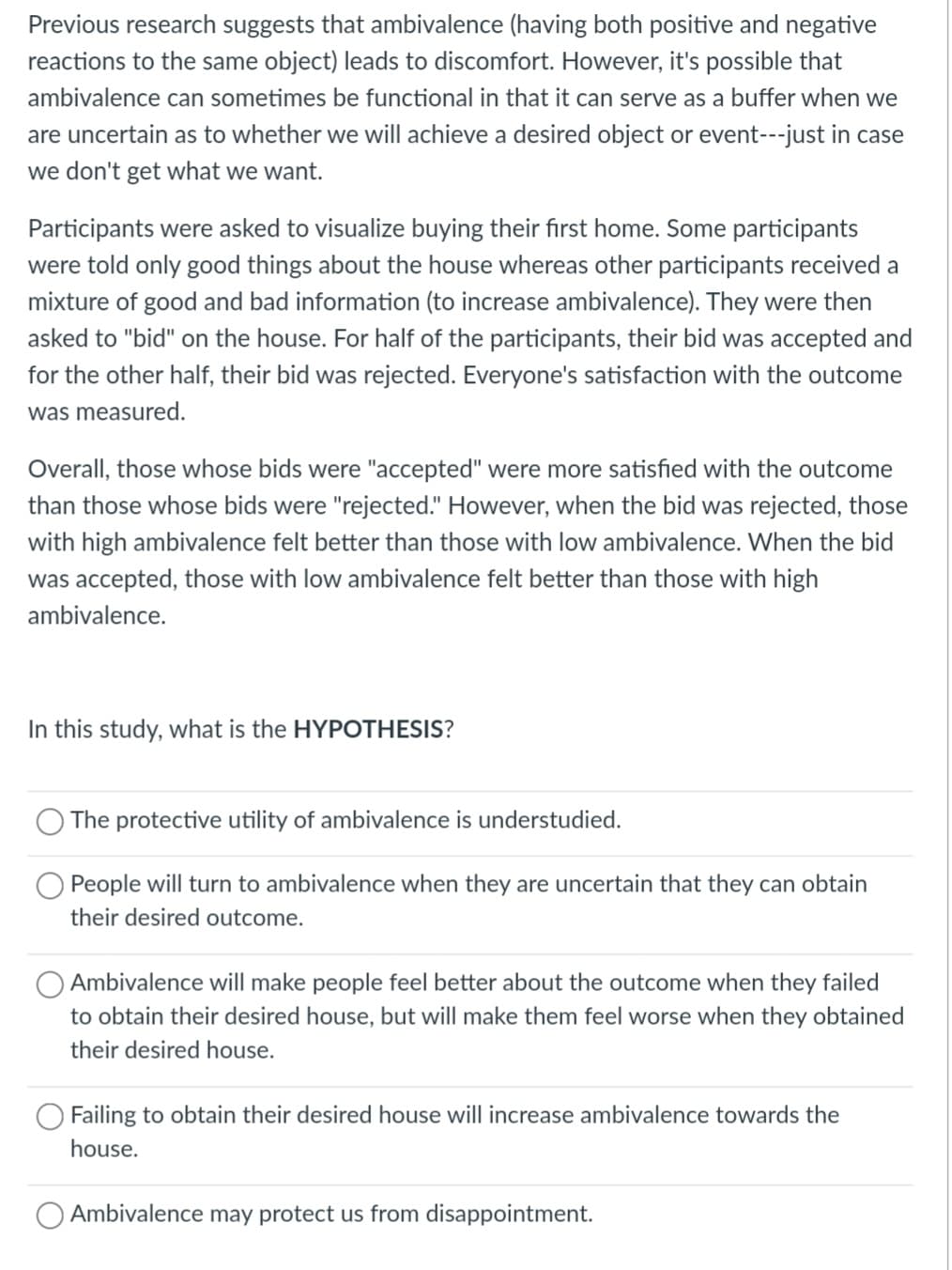Previous research suggests that ambivalence (having both positive and negative reactions to the same object) leads to discomfort. However, it's possible that ambivalence can sometimes be functional in that it can serve as a buffer when we are uncertain as to whether we will achieve a desired object or event---just in case we don't get what we want. Participants were asked to visualize buying their first home. Some participants were told only good things about the house whereas other participants received a mixture of good and bad information (to increase ambivalence). They were then asked to "bid" on the house. For half of the participants, their bid was accepted and for the other half, their bid was rejected. Everyone's satisfaction with the outcome was measured. Overall, those whose bids were "accepted" were more satisfied with the outcome than those whose bids were "rejected." However, when the bid was rejected, those with high ambivalence felt better than those with low ambivalence. When the bid was accepted, those with low ambivalence felt better than those with high ambivalence. In this study, what is the HYPOTHESIS? The protective utility of ambivalence is understudied. People will turn to ambivalence when they are uncertain that they can obtain their desired outcome. Ambivalence will make people feel better about the outcome when they failed to obtain their desired house, but will make them feel worse when they obtained their desired house. O Failing to obtain their desired house will increase ambivalence towards the house. Ambivalence may protect us from disappointment.
Previous research suggests that ambivalence (having both positive and negative reactions to the same object) leads to discomfort. However, it's possible that ambivalence can sometimes be functional in that it can serve as a buffer when we are uncertain as to whether we will achieve a desired object or event---just in case we don't get what we want. Participants were asked to visualize buying their first home. Some participants were told only good things about the house whereas other participants received a mixture of good and bad information (to increase ambivalence). They were then asked to "bid" on the house. For half of the participants, their bid was accepted and for the other half, their bid was rejected. Everyone's satisfaction with the outcome was measured. Overall, those whose bids were "accepted" were more satisfied with the outcome than those whose bids were "rejected." However, when the bid was rejected, those with high ambivalence felt better than those with low ambivalence. When the bid was accepted, those with low ambivalence felt better than those with high ambivalence. In this study, what is the HYPOTHESIS? The protective utility of ambivalence is understudied. People will turn to ambivalence when they are uncertain that they can obtain their desired outcome. Ambivalence will make people feel better about the outcome when they failed to obtain their desired house, but will make them feel worse when they obtained their desired house. O Failing to obtain their desired house will increase ambivalence towards the house. Ambivalence may protect us from disappointment.
Glencoe Algebra 1, Student Edition, 9780079039897, 0079039898, 2018
18th Edition
ISBN:9780079039897
Author:Carter
Publisher:Carter
Chapter10: Statistics
Section10.6: Summarizing Categorical Data
Problem 28PPS
Related questions
Question
100%
I am a little confused on this question , please help! please don't just list the answers , if you can explain how you got your answer that would be great. Thank you for your help.
I have attached the problem .Please view attachment before answering.

Transcribed Image Text:Previous research suggests that ambivalence (having both positive and negative
reactions to the same object) leads to discomfort. However, it's possible that
ambivalence can sometimes be functional in that it can serve as a buffer when we
are uncertain as to whether we will achieve a desired object or event---just in case
we don't get what we want.
Participants were asked to visualize buying their first home. Some participants
were told only good things about the house whereas other participants received a
mixture of good and bad information (to increase ambivalence). They were then
asked to "bid" on the house. For half of the participants, their bid was accepted and
for the other half, their bid was rejected. Everyone's satisfaction with the outcome
was measured.
Overall, those whose bids were "accepted" were more satisfied with the outcome
than those whose bids were "rejected." However, when the bid was rejected, those
with high ambivalence felt better than those with low ambivalence. When the bid
was accepted, those with low ambivalence felt better than those with high
ambivalence.
In this study, what is the HYPOTHESIS?
The protective utility of ambivalence is understudied.
People will turn to ambivalence when they are uncertain that they can obtain
their desired outcome.
Ambivalence will make people feel better about the outcome when they failed
to obtain their desired house, but will make them feel worse when they obtained
their desired house.
Failing to obtain their desired house will increase ambivalence towards the
house.
Ambivalence may protect us from disappointment.
Expert Solution
This question has been solved!
Explore an expertly crafted, step-by-step solution for a thorough understanding of key concepts.
Step by step
Solved in 2 steps

Recommended textbooks for you

Glencoe Algebra 1, Student Edition, 9780079039897…
Algebra
ISBN:
9780079039897
Author:
Carter
Publisher:
McGraw Hill

Glencoe Algebra 1, Student Edition, 9780079039897…
Algebra
ISBN:
9780079039897
Author:
Carter
Publisher:
McGraw Hill